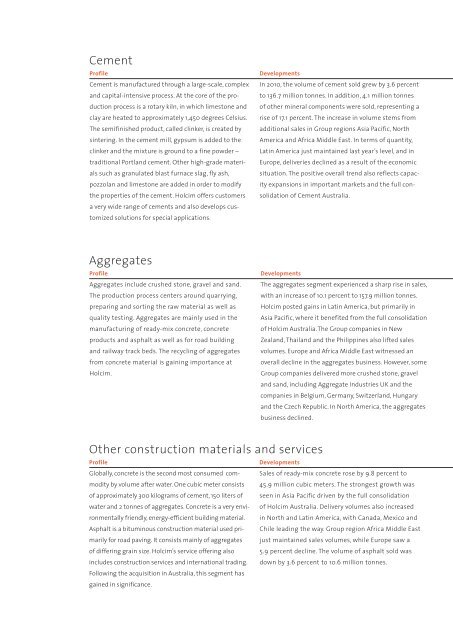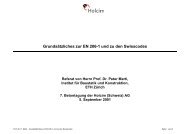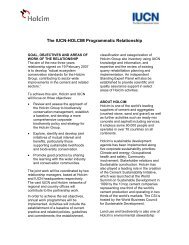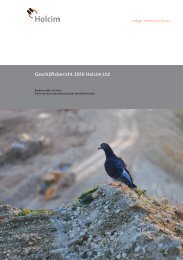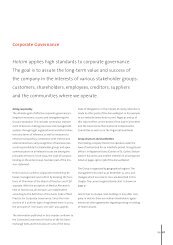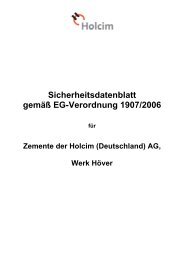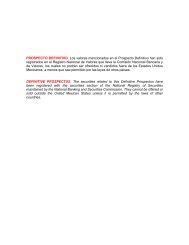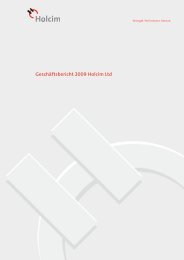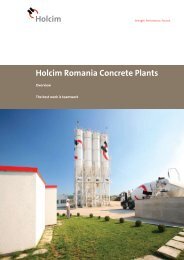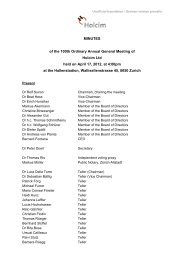Annual Report 2010 Holcim Ltd
Annual Report 2010 Holcim Ltd
Annual Report 2010 Holcim Ltd
Create successful ePaper yourself
Turn your PDF publications into a flip-book with our unique Google optimized e-Paper software.
Cement<br />
Profile<br />
Cement is manufactured through a large-scale, complex<br />
and capital-intensive process. At the core of the pro-<br />
duction process is a rotary kiln, in which limestone and<br />
clay are heated to approximately 1,450 degrees Celsius.<br />
The semifinished product, called clinker, is created by<br />
sintering. In the cement mill, gypsum is added to the<br />
clinker and the mixture is ground to a fine powder –<br />
traditional Portland cement. Other high-grade materials<br />
such as granulated blast furnace slag, fly ash,<br />
pozzolan and limestone are added in order to modify<br />
the properties of the cement. <strong>Holcim</strong> offers customers<br />
a very wide range of cements and also develops customized<br />
solutions for special applications.<br />
Aggregates<br />
Profile<br />
Aggregates include crushed stone, gravel and sand.<br />
The production process centers around quarrying,<br />
preparing and sorting the raw material as well as<br />
quality testing. Aggregates are mainly used in the<br />
manufacturing of ready-mix concrete, concrete<br />
products and asphalt as well as for road building<br />
and railway track beds. The recycling of aggregates<br />
from concrete material is gaining importance at<br />
<strong>Holcim</strong>.<br />
Other construction materials and services<br />
Profile<br />
Globally, concrete is the second most consumed commodity<br />
by volume after water. One cubic meter consists<br />
of approximately 300 kilograms of cement, 150 liters of<br />
water and 2 tonnes of aggregates. Concrete is a very environmentally<br />
friendly, energy-efficient building material.<br />
Asphalt is a bituminous construction material used primarily<br />
for road paving. It consists mainly of aggregates<br />
of differing grain size. <strong>Holcim</strong>’s service offering also<br />
includes construction services and international trading.<br />
Following the acquisition in Australia, this segment has<br />
gained in significance.<br />
Developments<br />
In <strong>2010</strong>, the volume of cement sold grew by 3.6 percent<br />
to 136.7 million tonnes. In addition, 4.1 million tonnes<br />
of other mineral components were sold, representing a<br />
rise of 17.1 percent. The increase in volume stems from<br />
additional sales in Group regions Asia Pacific, North<br />
America and Africa Middle East. In terms of quantity,<br />
Latin America just maintained last year’s level, and in<br />
Europe, deliveries declined as a result of the economic<br />
situation. The positive overall trend also reflects capacity<br />
expansions in important markets and the full consolidation<br />
of Cement Australia.<br />
Developments<br />
The aggregates segment experienced a sharp rise in sales,<br />
with an increase of 10.1 percent to 157.9 million tonnes.<br />
<strong>Holcim</strong> posted gains in Latin America, but primarily in<br />
Asia Pacific, where it benefited from the full consolidation<br />
of <strong>Holcim</strong> Australia.The Group companies in New<br />
Zealand, Thailand and the Philippines also lifted sales<br />
volumes. Europe and Africa Middle East witnessed an<br />
overall decline in the aggregates business. However, some<br />
Group companies delivered more crushed stone, gravel<br />
and sand, including Aggregate Industries UK and the<br />
companies in Belgium, Germany, Switzerland, Hungary<br />
and the Czech Republic. In North America, the aggregates<br />
business declined.<br />
Developments<br />
Sales of ready-mix concrete rose by 9.8 percent to<br />
45.9 million cubic meters. The strongest growth was<br />
seen in Asia Pacific driven by the full consolidation<br />
of <strong>Holcim</strong> Australia. Delivery volumes also increased<br />
in North and Latin America, with Canada, Mexico and<br />
Chile leading the way. Group region Africa Middle East<br />
just maintained sales volumes, while Europe saw a<br />
5.9 percent decline. The volume of asphalt sold was<br />
down by 3.6 percent to 10.6 million tonnes.


